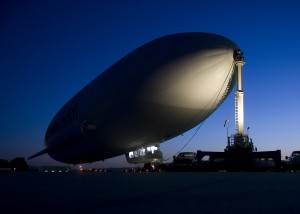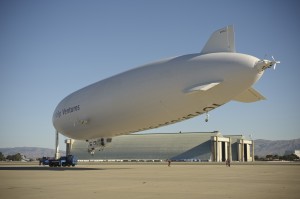Workshop to examine cargo airship feasibility in Alaska
August 17, 2012

907-451-2990
8/17/12
The University of Alaska Fairbanks and NASA will gather roughly 100 business executives, researchers and government officials in Anchorage next week for the second annual Cargo Airships for Northern Operations Workshop.
The workshop, which will run Aug. 22-24 at UAA, will examine how airships could transform Alaska’s commercial transportation system.
“Airship technologies have the potential to move fuel, construction equipment, and supplies to villages and projects in rural Alaska when ice roads, river ships and barges can’t do the job,” said. Lt. Gov. Mead Treadwell, the event’s keynote speaker. “Airships could have a significant effect on economics and life in the bush and the ultimate feasibility of energy and natural resource projects around the state.”
Airships—sometimes called “dirigibles” or “lighter-than-air aircraft”—land and take off vertically, like a helicopter. Inspired by 18th-century technology, modern airships are designed to carry up to 500-ton payloads, operate at high altitudes and serve a wide variety of commercial, defense and aerospace functions.
Workshop presenters from the mining, oil, gas and cargo industries will describe their unique transportation needs. Leading international airship developers will provide design and operational details on the newest developing airships and preparations for their commercial deployment, including
• The first-ever Canadian airship launch,
• The Skycat hybrid cargo airship for Alaska,
• First winged hybrid airship flight and
• The Russian hybrid airship, Augur ATLANT.
Commercial freight and shipping trends will be a key topic of discussion, as financial sector representatives outline funding options that could make the technology feasible in Alaska.

Among the 27 scheduled speakers are: former Lt. Gov. Craig Campbell, president and CEO of Alaska Aerospace Corporation; Alaska Sen. Lesil McGuire; and Tom Barrett, president of Alyeska Pipeline Services Company.
The conference is part of a NASA-State of Alaska partnership originating from a 2010 agreement that positioned the state as an airship proving ground.
“Airships play a key role in NASA’s science research,” said event speaker Pete Worden, director of the NASA Ames Research Center in Silicon Valley. “We’re pleased to be pursuing research opportunities with one of our partners in the NASA Research Park, Airship Ventures – as well as assisting the Department of Defense in their heavy-lift project with Aeros Corporation. Ames has a proud history of aeronautics research, pioneering new concepts and unique approaches to solving problems. I look forward to sharing with the workshop’s attendees information about our innovative work and goals involving airships.”
Most workshop activities will take place at the ConocoPhillips Integrated Science Building at UAA. The Alaska University Transportation Center at the UAF Institute of Northern Engineering, NASA Ames Research Center and ISO Polar are sponsoring the workshop.
ADDITIONAL CONTACTS: Lt. Gov. Mead Treadwell’s chief of staff Michelle Toohey 907-269-7460, michelle.toohey@alaska.gov. Billy Connor, director of the Alaska University Transportation Center, 907-474-5552, cell: 907-460-0061, bgconnor@alaska.edu. Mike Mewhinney, NASA Ames Research Center public affairs, 650-604-3937, Michael.mewhinney@nasa.gov.
ON THE WEB: http://event.arc.nasa.gov/airships/
NOTE TO EDITORS: The website includes a complete agenda and speaker biographies.
JH/8-17-12/047-13


